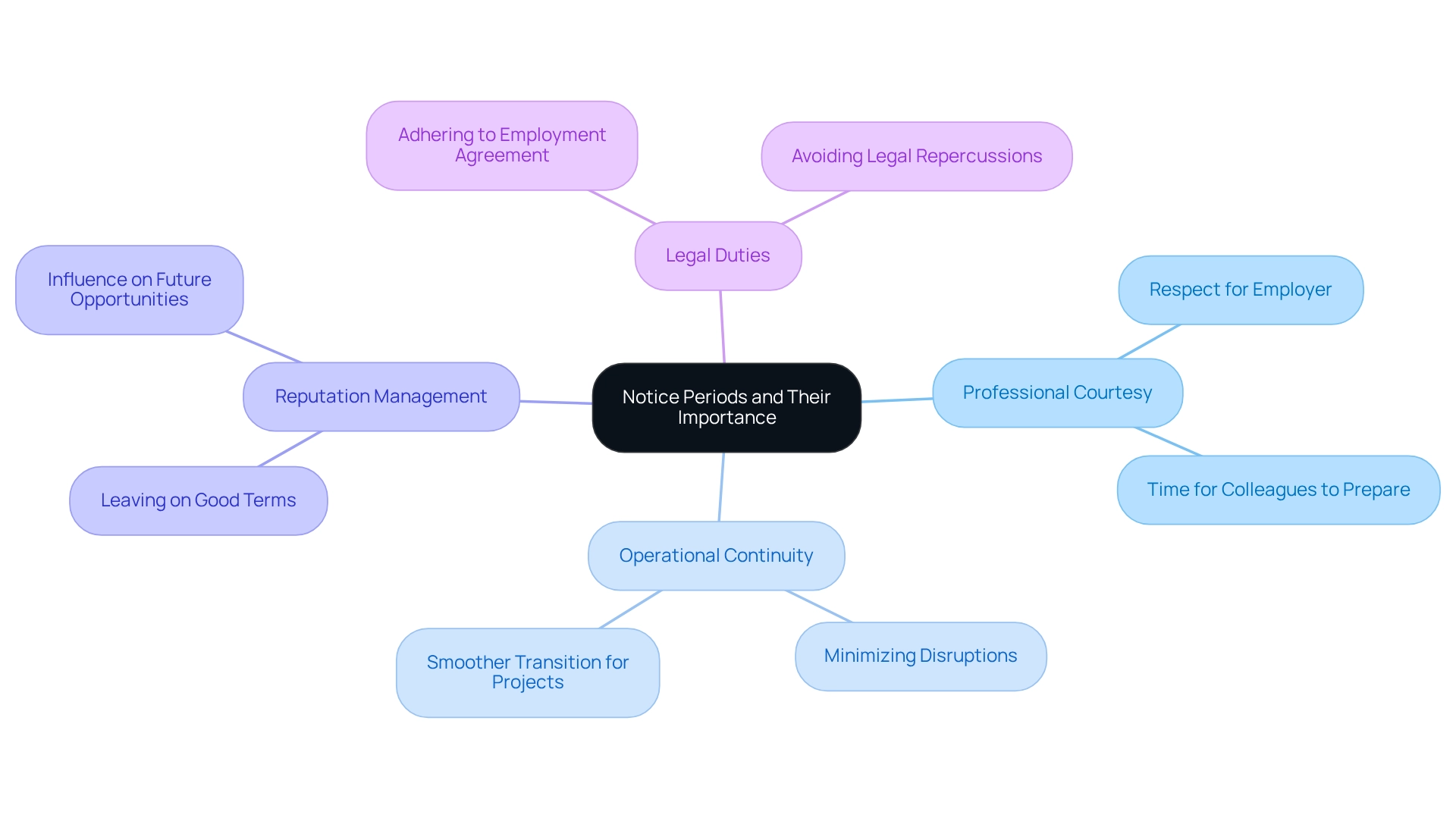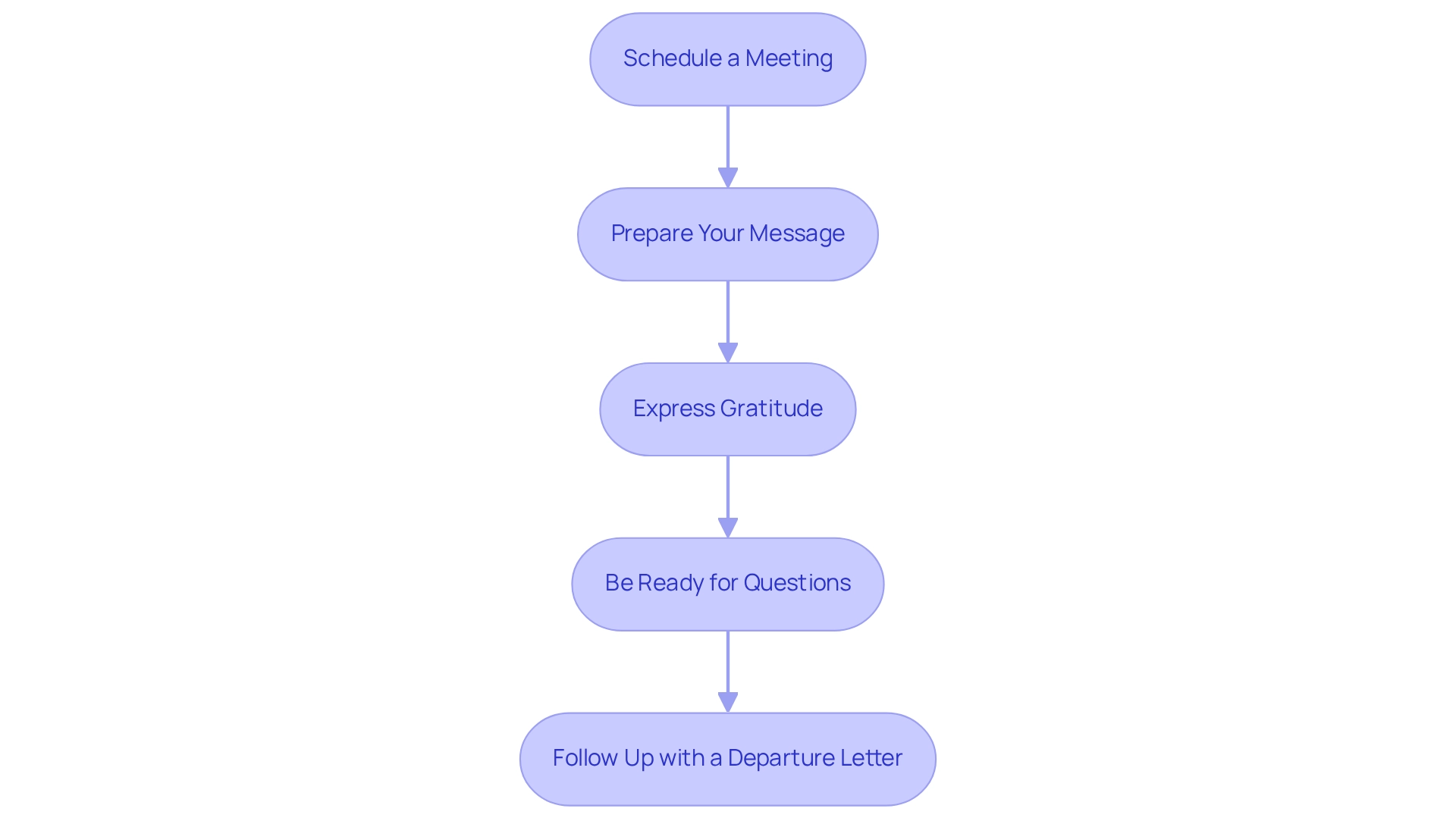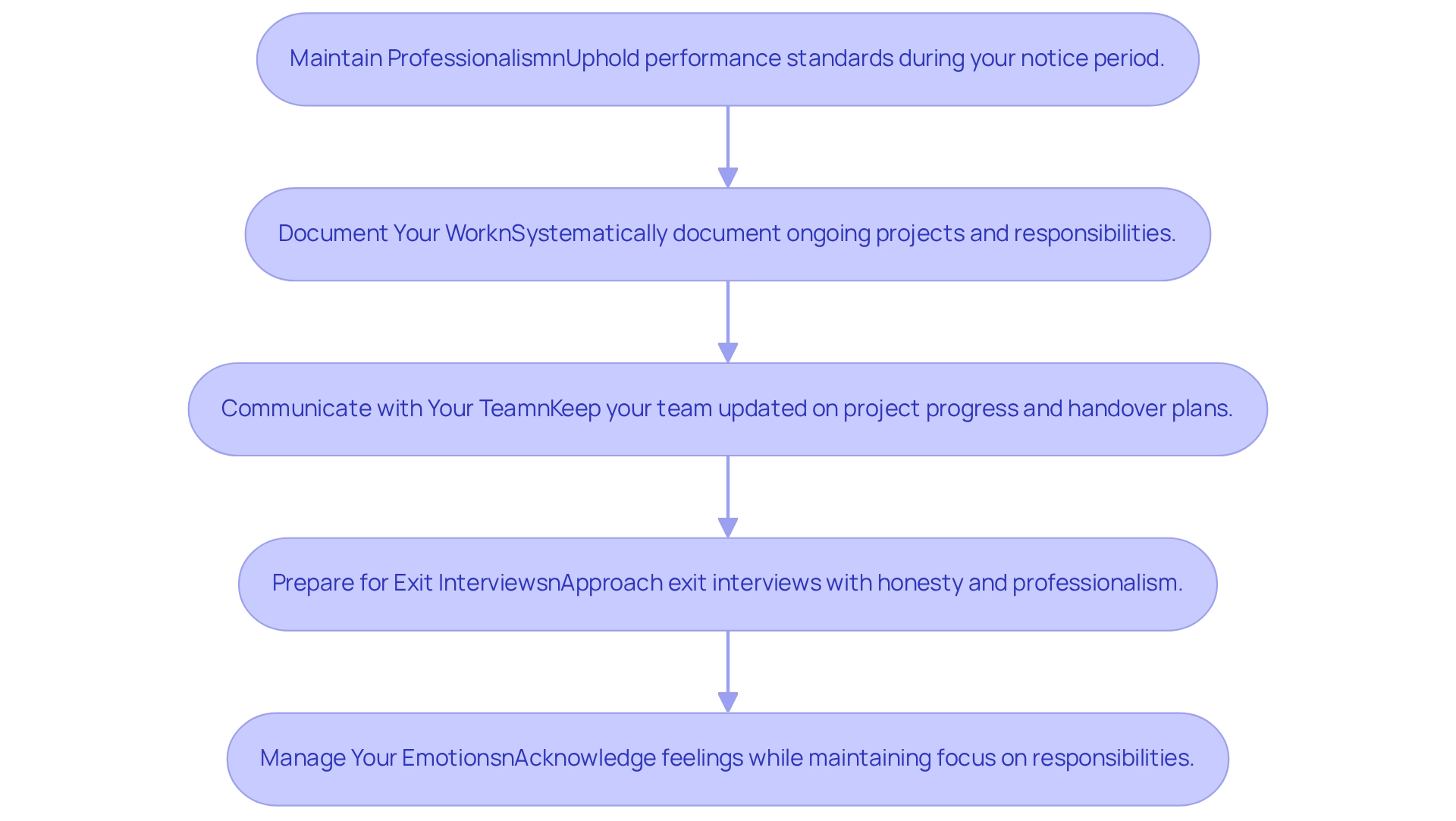Overview
The article delineates essential steps for providing notice that guarantee a seamless transition, underscoring the significance of professionalism, clear communication, and strict adherence to notice periods. It elaborates on how effective resignation practices, such as:
- Scheduling a meeting with a supervisor
- Meticulously documenting ongoing work
bolster operational continuity and preserve positive relationships. Ultimately, these practices yield advantages for both the employee and employer.
Key Highlights:
- Notice periods indicate how long an employee must work after resigning, typically around two weeks but can vary.
- Providing notice is a professional courtesy that allows organizations to prepare for employee departures.
- Effective notice management supports operational continuity and maintains a positive professional reputation.
- Adhering to contractual notice periods is crucial to avoid legal repercussions, such as forfeiting severance.
- Factors influencing notice period length include company policy, role responsibilities, tenure, industry standards, and personal circumstances.
- Effective resignation communication involves scheduling a meeting, preparing a clear message, expressing gratitude, and following up with a formal departure letter.
- During the notice period, employees should maintain professionalism, document their work, communicate with their team, prepare for exit interviews, and manage their emotions.
- Transparency and effective communication during the transition can alleviate concerns and foster goodwill among colleagues.
Introduction
In the intricate realm of professional transitions, the resignation process often presents a landscape filled with uncertainty and potential pitfalls. It is crucial for employees to grasp the nuances of notice periods to navigate this pivotal juncture with professionalism and respect.
Recognizing the significance of providing adequate notice and effectively communicating one’s resignation is paramount; each step plays a vital role in preserving a positive relationship with an employer. As organizations contend with the ramifications of employee turnover, insights into best practices can illuminate the path toward a smoother transition, ensuring that both parties emerge from the experience with their reputations intact and future opportunities safeguarded.
By exploring the intricacies of notice periods, employees can prepare themselves for the challenges that lie ahead, fostering goodwill and setting the stage for their next career chapter.
Understand Notice Periods and Their Importance
Notice times indicate the duration a staff member must continue working after submitting their resignation. While the standard notification period is typically two weeks, variations may arise based on company policy, the employee’s position, and the terms outlined in their employment agreement. Recognizing the importance of notification durations is essential for several reasons:
- Professional Courtesy: Providing advance notice is a widely accepted practice that demonstrates respect for your employer and colleagues, allowing them time to prepare for your departure.
- Operational Continuity: Notice durations facilitate a smoother transition for the organization, helping to minimize disruptions to ongoing projects and responsibilities.
- Reputation Management: Leaving on good terms is vital for maintaining your professional reputation, which can significantly influence future job opportunities and references.
- Legal Duties: Adhering to the notification timeframe specified in your agreement is crucial; failing to do so may result in legal repercussions, such as forfeiting severance compensation or incurring fines.
Data reveals that a 1-percent increase in hourly wages correlates with a 0.28 percent decrease in the resignation rate, underscoring the financial implications of staff turnover. Furthermore, research indicates that disengaged managers contribute to a financial burden of $77 billion to $96 billion annually on the U.S. economy, highlighting the necessity of effective exit processes to mitigate turnover costs.
Case analyses demonstrate that organizations with clearly defined guidelines on notification durations experience smoother transitions and maintain higher staff morale. For instance, companies that prioritize professional courtesy in departures often see improved retention rates and a more engaged workforce. Specific examples include organizations that have implemented structured exit interviews and transition strategies, which not only streamline the notification period but also foster a culture of respect and professionalism.
By understanding these factors, individuals can navigate their departures more effectively, ensuring they maintain positive relationships with their employers and contribute to a culture of respect and professionalism. Moving forward, it is imperative for staff to prepare for their forthcoming actions, including how to give notice and what to expect during the transition.
Determine the Right Length of Your Notice Period
To determine the appropriate length of your notice period, consider the following factors:
-
Company Policy: Start by examining your employee handbook or contract to comprehend the standard notification duration required by your employer. In 2025, most companies anticipate at least two weeks’ notification, although some may need more, especially for senior positions.
-
Role and Responsibilities: If you hold a vital role or are involved in ongoing projects, an extended advance time may be required to ensure a seamless transfer of your duties.
-
Tenure: Employees with longer tenures are often expected to give more advance warning, reflecting their deeper involvement and contributions to the organization.
-
Industry Standards: Various sectors possess distinct practices concerning notification durations. Researching these standards can provide valuable context for your decision-making process. For instance, in 2025, the average advance period required by companies in the financial sector is often around four weeks, especially for roles that are pivotal to operations.
-
Personal Circumstances: Take into account your own situation, including any upcoming commitments or job offers, which may influence how much notice you can realistically provide. Remember, candidates often feel the pressure to accept the first job offer they receive, but it’s crucial to explore all options to ensure the best fit for long-term career success.
Additionally, it’s important to understand how to give notice while maintaining positive relationships during your resignation process. Statistics indicate that nearly half of the workforce stated they would depart if their organization did not acknowledge or appreciate them for their efforts. This highlights the need for effective communication. As McKinsey states, “If you communicate effectively with your staff, you can enhance their productivity.” By ensuring clear communication, you can foster goodwill, which is beneficial for both you and your employer.
By carefully evaluating these factors and considering the insights from best practices to reduce employee turnover, you can select a notice period that aligns with both your professional obligations and personal circumstances, ensuring a respectful and smooth transition.
Communicate Your Resignation Effectively
Effectively communicating your resignation involves several key steps:
- Schedule a Meeting: Request a private meeting with your supervisor to discuss your departure. This demonstrates respect and facilitates a more personal conversation.
- Prepare Your Message: Prior to the meeting, outline your key points. Keep your message concise and professional, beginning with your intention to resign and your proposed last working day.
- Express Gratitude: Acknowledge the opportunities you’ve had during your tenure. Expressing gratitude fosters a positive impression and may benefit future references. As Eric Eddy noted, Boutique Recruiting’s ability to deliver top-notch candidates quickly and efficiently underscores the importance of maintaining professional relationships.
- Be Ready for Questions: Your supervisor may inquire about your decision. Prepare to answer honestly yet diplomatically, focusing on your reasons for leaving without being overly negative.
- Follow Up with a Departure Letter: After your meeting, submit a formal departure letter that includes a formal salutation, a statement of your desire to leave, your specified effective date, and appreciation for the opportunities received. This serves as a documented account of your departure and ensures clarity.
By following these steps, you can convey your departure in a respectful and professional manner, helping to maintain positive relationships with your employer and colleagues. Effective communication during this process is crucial, as it can significantly impact your professional reputation and future opportunities. Additionally, be mindful of communication barriers such as unfit internal technology and high volumes of communication, which can affect how your message is received. Choosing the right method of communication, such as video calls—which 25.34% of UK workers utilize—can enhance the effectiveness of your resignation process.
Navigate Your Notice Period: Expectations and Challenges
Managing your transition phase necessitates a clear comprehension of expectations and readiness for possible obstacles. Consider this: statistics indicate that 92% of candidates never finish their job applications, underscoring the critical role of effective communication and professionalism in retaining talent.
- Maintain Professionalism: Uphold your performance standards throughout your notice period. This commitment not only reflects positively on your professional reputation but also reinforces your dedication to the organization. As Geoff Whiting noted, improving organizational elements can significantly reduce employee turnover, highlighting the importance of maintaining professionalism during this time.
- Document Your Work: Systematically document your ongoing projects and responsibilities. This practice aids your colleagues in transitioning your workload and ensures continuity in operations.
- Communicate with Your Team: Keep your team updated on your project progress and any handover plans. Transparent communication can alleviate concerns regarding your departure and foster a collaborative environment. It’s noteworthy that candidates often abandon recruitment processes due to poor communication, emphasizing the need for clarity during your transition. Embracing transparency about your reasons for leaving, including your desired work arrangements and future plans, can enhance trust and understanding among your colleagues.
- Prepare for Exit Interviews: Anticipate an exit interview where you may provide feedback about your experience. Approach this opportunity with honesty and professionalism, focusing on constructive insights that can benefit the organization. Sharing your genuine thoughts can help create a more open dialogue and may lead to positive changes in the workplace.
- Manage Your Emotions: Recognize that leaving a job can evoke strong emotions. While it’s important to acknowledge your feelings, maintain focus on your responsibilities. Avoid participating in negative conversations regarding your employer or coworkers during this time. Being authentic about your feelings, while still maintaining professionalism, can help you navigate this emotional landscape more effectively.
Understanding these expectations and challenges will empower you to navigate your notice period effectively, ensuring a seamless transition for both yourself and your employer. Many employees leave jobs due to poor management and toxic workplace environments, as noted in the case study on low engagement. By adhering to these guidelines, you can positively impact your references and future opportunities.
Conclusion
Navigating the resignation process and understanding notice periods is critical for a successful professional transition. Providing adequate notice transcends mere formality; it embodies professionalism and respect for both the employer and colleagues. By adhering to established notice periods, employees not only contribute to operational continuity but also uphold their professional reputation and fulfill any legal obligations tied to their employment contracts. These practices are essential, as they help maintain positive relationships and mitigate the financial implications associated with employee turnover.
Determining the appropriate length of notice necessitates careful consideration of various factors, including company policies, role responsibilities, and personal circumstances. Clear communication during the resignation process is equally crucial; it sets the tone for future interactions and can significantly impact career opportunities. Approaching the resignation conversation with gratitude and professionalism can leave a lasting positive impression.
As employees navigate their notice periods, maintaining professionalism and transparency becomes paramount. Documenting work, communicating effectively with teams, and preparing for exit interviews are all critical steps that ensure a smooth transition. By managing emotions and focusing on responsibilities, individuals can foster goodwill, ultimately benefiting their career trajectories.
In summary, understanding the intricacies of notice periods equips employees to handle resignations with grace and professionalism. As organizations increasingly value respectful transitions, taking these steps can pave the way for future opportunities and preserve essential professional relationships.
Frequently Asked Questions
What is the standard notice period after submitting a resignation?
The standard notice period is typically two weeks, but it may vary based on company policy, the employee’s position, and the terms outlined in their employment agreement.
Why is providing notice important?
Providing notice is important for several reasons, including professional courtesy, operational continuity, reputation management, and legal duties.
How does professional courtesy relate to notice periods?
Professional courtesy involves giving advance notice to demonstrate respect for your employer and colleagues, allowing them time to prepare for your departure.
What is the impact of notice durations on operational continuity?
Notice durations help facilitate a smoother transition for the organization, minimizing disruptions to ongoing projects and responsibilities.
How can leaving on good terms affect future job opportunities?
Leaving on good terms is vital for maintaining your professional reputation, which can significantly influence future job opportunities and references.
What are the legal implications of not adhering to the notice period?
Failing to adhere to the notification timeframe specified in your agreement may result in legal repercussions, such as forfeiting severance compensation or incurring fines.
What does research say about the financial implications of staff turnover?
Data shows that a 1-percent increase in hourly wages correlates with a 0.28 percent decrease in the resignation rate, highlighting the financial implications of staff turnover.
How do disengaged managers affect the economy?
Disengaged managers contribute to a financial burden of $77 billion to $96 billion annually on the U.S. economy, emphasizing the necessity of effective exit processes to mitigate turnover costs.
What benefits do organizations gain from clearly defined guidelines on notification durations?
Organizations with clearly defined guidelines on notification durations experience smoother transitions and maintain higher staff morale.
How can structured exit interviews and transition strategies improve retention rates?
Companies that implement structured exit interviews and transition strategies often see improved retention rates and a more engaged workforce, fostering a culture of respect and professionalism.






